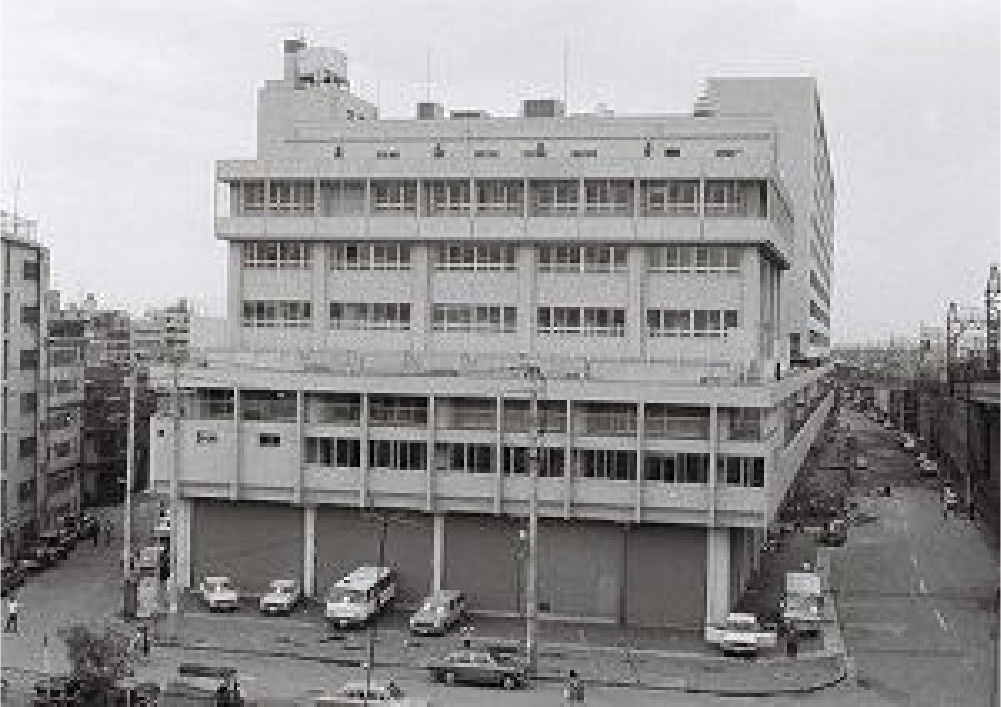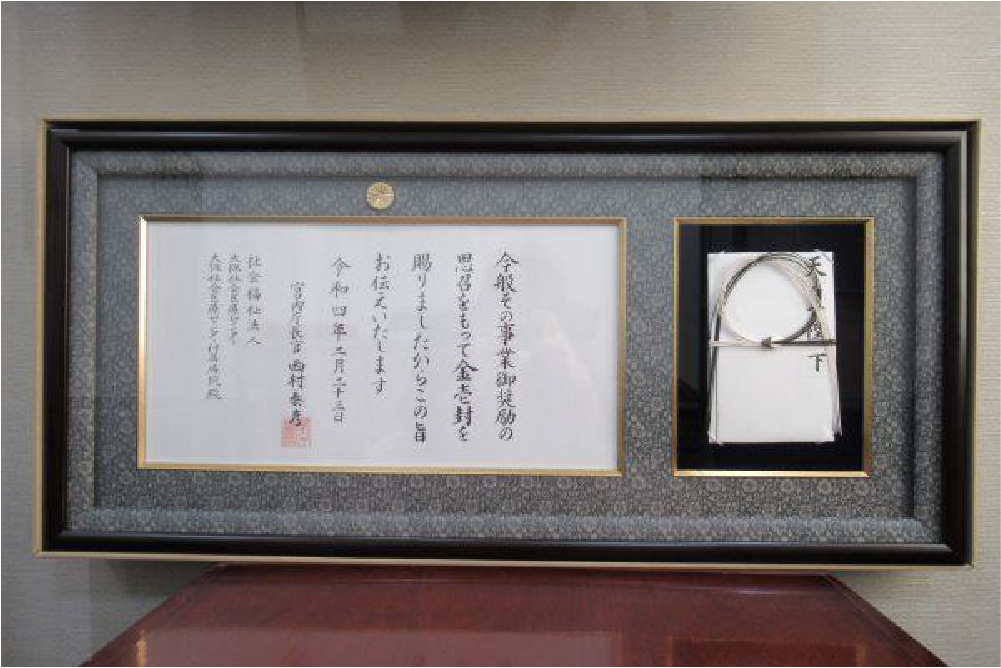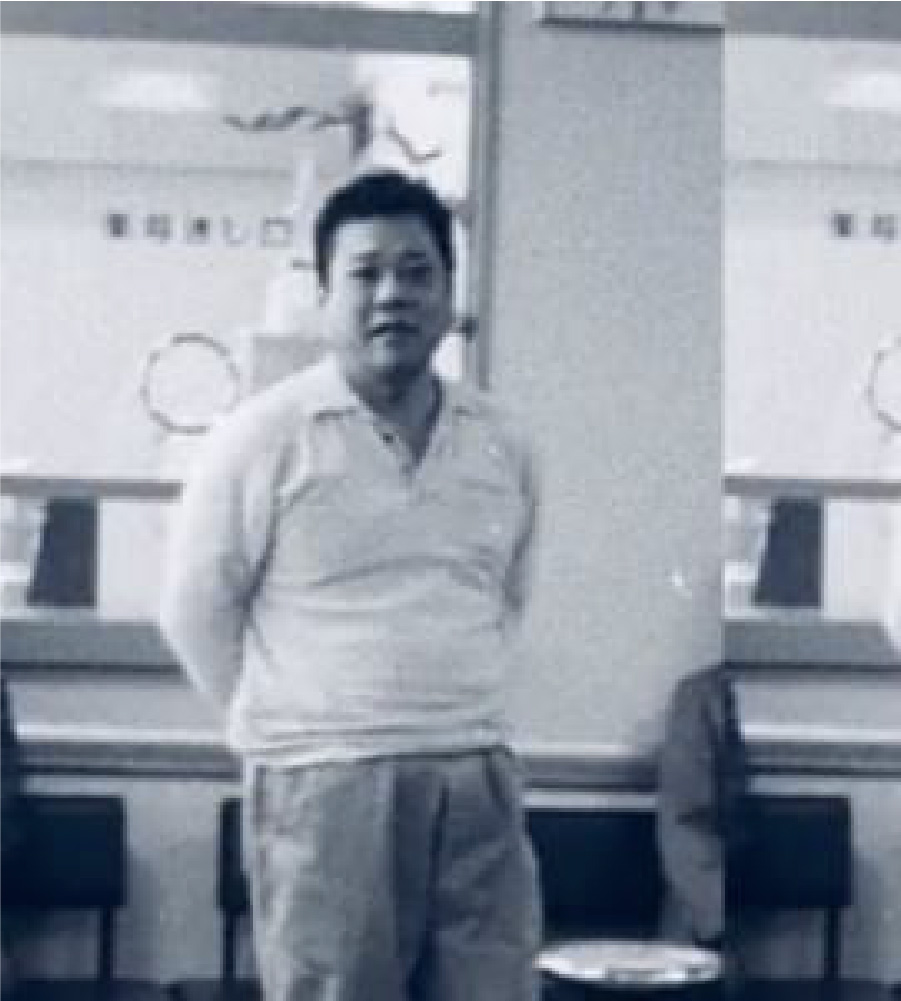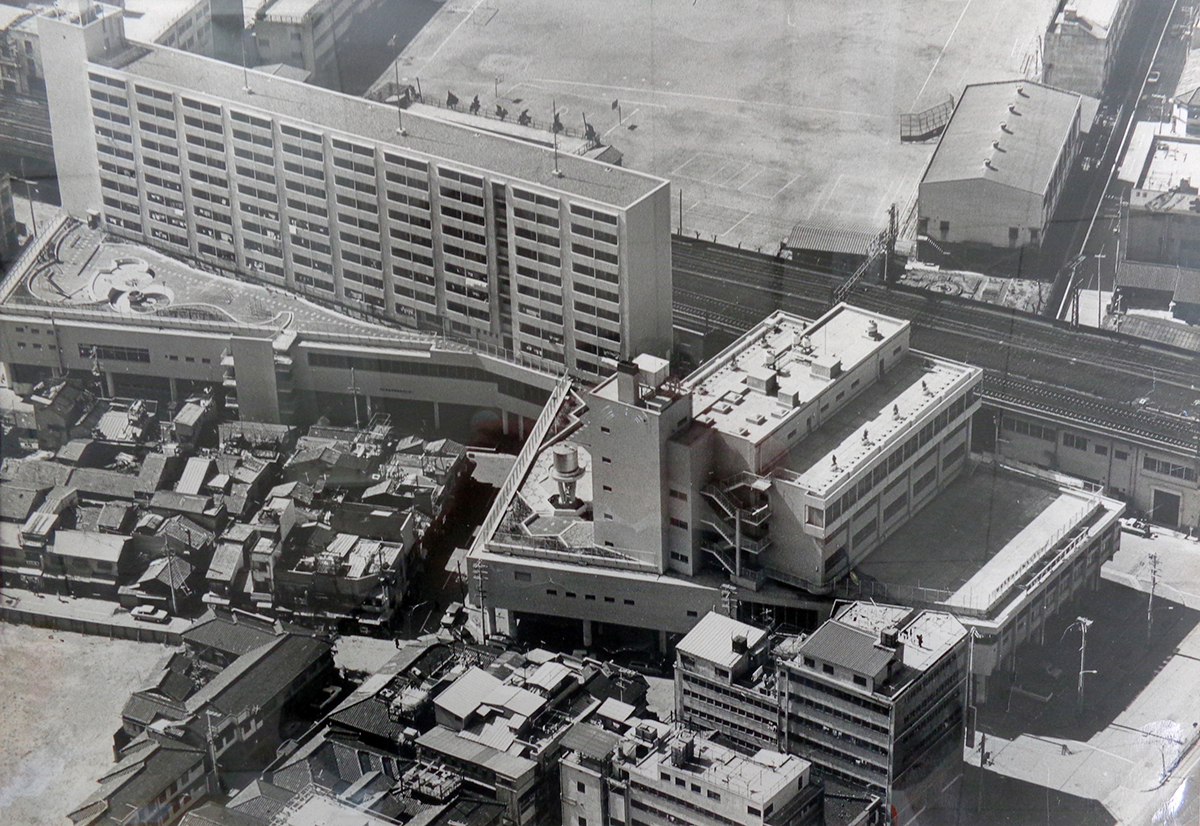沿革
大阪社会医療センター50年のあゆみ

沿革
| 昭和45年7月 | 財団法人大阪社会医療センター設立(西成区萩之茶屋一丁目3番44号) |
| 昭和45年9月 | 外来業務開始 |
| 昭和45年12月 | 入院業務開始(一般病床100床) |
| 昭和47年7月 | 財団法人から社会福祉法人へ改組 |
| 昭和59年4月 | 歯科診療所開設 |
| 平成15年8月 | 一般病床80床に変更 |
| 平成25年3月 | 歯科診療所廃止 |
| 令和2年8月 | 新病院建屋竣工 |
| 令和2年12月 | 現在地(西成区萩之茶屋一丁目11番6号)へ移転 新病院での診療開始  電子カルテシステム新規導入 一般病床50床、療養病床30床に変更 |
| 令和3年5月 | 新型コロナウイルス感染症軽症中等症患者の受入を開始 |
| 令和3年7月 | 法人設立50周年 |
| 令和4年2月 | 天皇陛下より御下賜金を賜る 訪問看護ステーション開設 |
| 令和6年10月 | 療養病床30床を地域包括ケア病床に変更 |
初代病院長 本田良寛について
生没年
大正14(1925)年2月27日大阪府大阪市城東区西鴫野生まれ、昭和60(1985)年7月1日没。
Born:February 27, 1925
Died:July 1, 1985
Birthplace:Nishi-Shigino, Joto Ward, Osaka, Japan

学歴
鯰江幼稚園
偕行社附属小学校(追手門学院小学校の前身)
八尾中学
八尾高校
徳島医専(徳島医専廃校後により転入学)
大阪市立医学専門学校(現・大阪市立大学医学部)
Namazue kindergarten, Elementary School Attached to Kaikosya (the predecessor of Otemon Gakuin Elementary School), Yao Senior High School, Tokushima Medical College (closed in 1947, and then transferred to), Osaka City Medical College (the predecessor of Osaka City University, Faculty of Medicine)
経歴
昭和24年医院を開業していた父親が亡くなり、城東区の医院を継いだ後、自宅から10分の大阪城東側に戦後に出現した集落(※1)の住民たちと約10年間心温まる交流を続け、集落の解散にまでこぎつけたエピソードの持ち主。
昭和45年からは、父の代から40年間続いた医院を閉院し、西成区の愛隣総合センター内に完成した大阪社会医療センター付属病院の初代院長としてあいりん地区(釜ヶ崎)で日雇い労働者たちへの医療に献身的に従事し、“赤ひげ先生”、“りょうかん先生”と慕われた。
He succeeded to his fatheru2019s clinic in 1949 (Showa 24) because of his death. He had treated and taken good care of his neighbors, especially the people who lived in the ruins of Osaka Army Arsenal severely damaged by bombing during WWII. They collected metal scraps and made their living by selling them. But this was illegal and the police often cracked down on their activity. The friendship between Dr. Honda and them had continued for about 10 years. And it led to the dissolution of the community and a park was developed there by local government.n In 1970 (Showa 45), he closed the clinic which was practiced for 40 years from his father. The Osaka Social Medical Center was founded by him and his coworkers. He assumed the post of first director of this center. He was devotedly engaged in medical care for day laborers in Airin (also called Kamagasaki) area and used to be friendly called Mr. Ryokan(1) or Mr. Akahige(2).
※1 集落
昭和33年ころ、公園整備が本格化していた大阪砲兵工廠(こうしょう)の跡地に、夜な夜な男たちが出没。男たちは組を作り、立入り禁止の一帯から、売れる金属類を掘り出した。
著書
「にっぽん釜ヶ崎診療所」(昭和41年、朝日新聞社)、「釜ヶ崎かて明日がある」(昭和47年、日新報道)などの著書がある。
- “Nippon Kamagasaki shinryosyo” (“Japan Kamagasaki clinic”), in 1966, the Asahi Shimbun
- “Kamagasaki kate Asugaaru” (We, Day Laborer in Kamagasaki, shall have a tomorrow”), in 1972, Nishinhodo, and other books.
主な受賞名
大阪文化賞(昭和41年)、昭和55年に「あいりん地域の医師として尽力すること17年、地域医療対策に多大な成果をあげている」として吉川英治文化賞を受賞。日本公衆衛生会長表彰ほか、14件の表彰状、感謝状が贈られた。
- The Osaka Culture Award in 1966,
- Yoshikawa Eiji Culture Award in 1980 (for his hard work as a doctor and a great achievement of the community-based medical care in Airin district for 17 years)
- Japan Public Health Association Presidential Award, and 14 certificates of achievement and letters of appreciation.
本田初代院長の事績
- 中学時代は“始末書のレコードホルダー”と呼ばれ、ケンカの“校内マッチ”、 “対校マッチ”をはじめ、武勇談は数知れなかった。
- 中学5年に進んだ時、担任の三刀先生に「お前は頭が悪いのではない。勉強せんからあかんのや。今からでも遅うない。」とハッパをかけられて発奮。徳島県立医専に合格して医師としての道を歩む。
- 昭和24年大阪市立医学専門学校を卒業後、父親を継いで開業し、医師会での調査広報委員会委員としての仕事の中で社会医学に開眼。
- 昭和34年8月地元鴫野の集落での医療活動を通して、集落の解散につなげた。
- 昭和38年1月4日に乞われて大阪市西成区の通称「釜ケ崎」と呼ばれた地域の大阪府済生会今宮診療所長(大正2年設立。現在の大阪社会医療センターの前身)の四代目所長となり、釜ヶ崎に赴く。
- 所長として赴任するに当たり、大阪市立大学医学部・大阪府済生会と本人の三者で、公衆衛生活動を含む調査研究の実施、医療活動は本人に一任し、人、物品、資材は提供する、重要な事項は三者の責任で話し合うことなどが確認された。
- それまで短期間で入れ替わっていった所長と違い、親の代から開業していた医院を閉じてまで腰を据えて低所得の労働者たちの医療に打ち込んだ。
- 「ある時払いの催促なし」という借用方式の無料低額診療事業を実践して社会医療に打ち込み、良寛(りょうかん)先生と親しまれた。
- 昭和36年、本田所長をモデルにして、映画「おへその大将」、「背と腹(芸術祭参加作品)」、テレビ「大阪野郎」等が描かれた。
- 昭和39年、ある人生(※2)「良寛先生」がNHKで放送され、あいりん地域の厳しい現実と本田所長のほのぼのとした医師の人柄を描き出した。ある人生は昭和39年11月1日から6年半にわたって放送。第一回目の放送に本田所長が登場。NHKアーカイブズは、平成14年9月1日、平成20年8月16日(土)にも再放送された。
- 大阪府済生会今宮診療所は、放送の6年後の昭和45年に発展的に解消し、同じ地区に大阪社会医療センター付属病院(許可病床数100床の病院、現在80床)として生まれ変わり、本田医師は昭和45年に大阪社会医療センターの初代院長に就任。
- その後、引き続き、”西成の赤ひげ”として俗称釜ヶ崎(あいりん地区)の労働者や地域の医療活動に献身。
- 昭和60年7月1日、胃がんのため60歳で死去するまでの15年間、同病院長として活躍した。
- 生前に「遺体は市大医学部に献体し、葬式はするな」と遺言していたが、東住吉区長居公園1の臨南寺会館で大阪社会医療センター葬として行われた。遠方にかかわらず、世話になった作業着、サンダルばき、ゴム長靴姿の労働者約80人があいりん地区からバスで集まり、「わしらの気持ちを本当にわかってくれた人だった」と合掌し、参列者計約千人が献花し、別れを惜しんだ。
※2 NHKヒューマンドキュメンタリー「ある人生」
社会の様々な分野で一途に生きる人々を取り上げたヒューマンドキュメンタリー「ある人生」は、1964年(昭和39年)11月1日から6年半にわたって放送され、自分をなげうってまで他の人のために生きた人物を追った作品。
- In his high school day he often fought with schoolmate or students of other schools and usually beat them. He was the person who wrote the most letters of apology in his school.
- Final year of high school Mr. Mito, his homeroom teacher, said to him u2018You are by no means unintelligent. You are just lazy. Even now it’s not too late.u2019 Thereafter he studied hard and was accepted to the Tokushima Medical College to walk the path to becoming a doctor.
- After graduated Osaka City Medical College in 1949 (Showa 24), he succeeded to his fatheru2019s clinic and became interested in social medicine through his experience as a , which was transformed into a public park member of research and public information committee in a medical association
- Dr. Hondau2019s clinic was located in Shigino, Joto Ward, Osaka. There had been the ruins of Osaka Army Arsenal severely damaged by bombing during WWII, which was transformed into a public park in late 1950u2019s. Some people lived there illegally and they were good neighbors of him. He had been taken care of them and supported to move from there.
- On January 4th 1963 (Showa 38), he was asked to become the fourth director of Osaka Prefecture Saiseikai Imamiya clinic. It was the predecessor of Osaka Social Medical Center, located in commonly called Kamagasaki, the day laboreru2019s area, Nishinari Ward, Osaka and founded in 1913 (Taisyo 2).
- When he became the director, the following agreements were confirmed among Osaka City University Faculty of Medicine, Osaka Prefecture Saiseikai and him. 1, performing surveys and research including public health activities. 2, medical service was left to Dr. Honda and they provided articles, materials, and human resources, 3, all three are equally responsible for discussing important issues. Unlike the former directors who were transferred after their short terms of office, he earnestly dedicated himself to the medical care for poor laborers.
- The low or free medical care system was established based on the idea, You can pay back at your convenience without a reminder . The poor without health insurance have been offered free or low-cost medical services. He provided medical care for socially vulnerable people and was well known among the people as a Ryokan-sensei or Mr. Ryokan1).
- In 1961 (Showa 36), films and TV dramas were made as a model of his life, including Oheso no Taisyo ( A Boss of navel ), Se to hara ( The belly and the back ), Osaka yaro ( Osaka Guy ), etc.
- In 1964 (Syowa 39), NHK (Japanese public broadcasting) put Ryokan Sensei ( Mr. Ryokan )(1) on the air in a television serial of Aru Jinsei ( A way of life ). In this TV broadcasting, his heartwarming medical care and the peopleu2019s severe social situations were described. Aru Jinsei broadcasted for six and half years, and the first program was Dr. Hondau2019s Ryokan sensei(1) , which was rebroadcasted two times on September 1st, 2002 (Heisei 12) and August 16th, 2008 (Heisei 20).
- Osaka Prefecture Saiseikai Imamiya clinic was reorganized as the Osaka Social Medical Center in 1970, and Dr. Honda assumed the post of first director of this center.
- He continued to devote himself to providing medical cares for laborers in Airin (commonly called Kamagasaki) area as a? Nishinariu2019s Akahige ( Nishinariu2019s Dr. Redbeard )(2).
- He provided medical service as a director of the hospital for 15 years until his death of gastric cancer on July 1st, 1985 (Syowa 60).
- While he was alive, he said, Donate my body to Osaka City University Medical School and donu2019t hold a funeral. But the funeral ceremony was held as Osaka Social Medical Center funeral in Rinnanji Kaikan located in Nagai Park in Higashi-Sumiyoshi Ward, Osaka. About 80 laborers in working clothes with sandals and rubber boots gathered and rushed over his funeral by the buses all the way. They said that he had plenty of heart for them. A total of about 1000 people offered flowers and were reluctant to part from him.
(1) Ryokan is another pronunciation of his first name. And also there was a renowned Soto Zen Buddhist monk, called Ryokan in the Edo period. He loved neighboring poor people, lived simple life and didnu2019t play up to the power all his life.
(2) Mr. Akahige (The Tales of Dr. Redbeard, 1958) is a hero of the historical novel written by Shugoro Yamamoto and a Japanese film directed by Akira Kurosawa in 1965. Mr. Akahige is a medical doctor and takes care of poor people in Edo period.
参考文献
- コトバンク
- 八尾高校「百年誌」人物抄
- 大阪府立八尾高等学校同窓会HP
- 平成9年12月17日 産経新聞記事
- NHKアーカイブズ
- 大阪社会医療センター創立25周年誌
- Kotobank
- The 100th anniversary magazine of Yao senior high school u201cProfileu201d
- Home page of Osaka prefectural Yao senior high school reunion
- The article of Sankei Shimbun on December 17th, 1997 (Heisei 9)
- NHK archives
- The 25th anniversary magazine of Osaka Social Medical Cente

